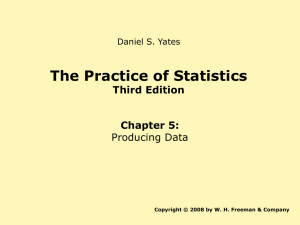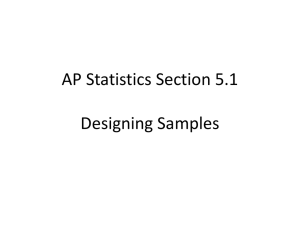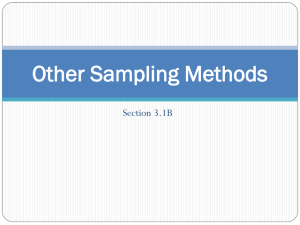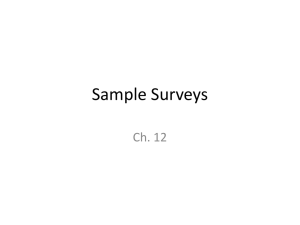Chap 8
advertisement
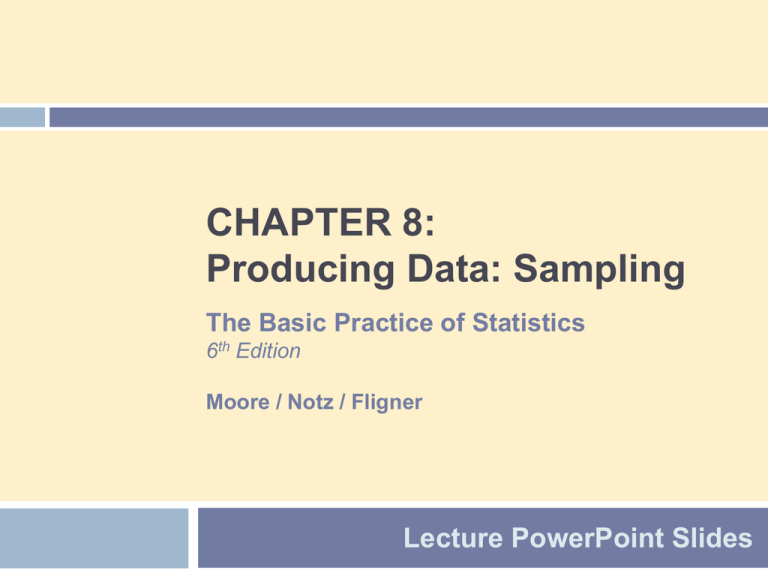
CHAPTER 8: Producing Data: Sampling The Basic Practice of Statistics 6th Edition Moore / Notz / Fligner Lecture PowerPoint Slides Chapter 8 Concepts 2 Population vs. Sample How to Sample Badly Simple Random Samples Inference About the Population Other Sampling Designs Cautions About Sample Surveys Chapter 8 Objectives 3 Identify the population and sample in a survey Identify bad sampling methods Select a simple random sample Describe different sampling methods Recognize cautions about sample surveys Describe how to make an inference about the population from a sample Population and Sample 4 The distinction between population and sample is basic to statistics. To make sense of any sample result, you must know what population the sample represents. The population in a statistical study is the entire group of individuals about which we want information. A sample is the part of the population from which we actually collect information. We use information from a sample to draw conclusions about the entire population. Population Collect data from a representative Sample... Sample Make an Inference about the Population. How to Sample Badly 5 The design of a sample is biased if it systematically favors certain outcomes. Choosing individuals who are easiest to reach results in a convenience sample. A voluntary response sample consists of people who choose themselves by responding to a general appeal. Voluntary response samples show bias because people with strong opinions (often in the same direction) are most likely to respond. Simple Random Samples 6 Random sampling, the use of chance to select a sample, is the central principle of statistical sampling. A simple random sample (SRS) of size n consists of n individuals from the population chosen in such a way that every set of n individuals has an equal chance to be the sample actually selected. In practice, people use random numbers generated by a computer or calculator to choose samples. If you don’t have technology handy, you can use a table of random digits. How to Choose a SRS 7 A table of random digits is a long string of the digits 0, 1, 2, 3, 4, 5, 6, 7, 8, 9 with these properties: • Each entry in the table is equally likely to be any of the 10 digits 0–9. • The entries are independent of each other. That is, knowledge of one part of the table gives no information about any other part. How to Choose an SRS Using Table B Step 1: Label. Give each member of the population a numerical label of the same length. Step 2: Table. Read consecutive groups of digits of the appropriate length from Table B. Your sample contains the individuals whose labels you find. SRS Example 8 Use the random digits provided to select an SRS of 4 hotels. 01 Aloha Kai 02 Anchor Down 03 Banana Bay 04 Banyan Tree 05 Beach Castle 06 Best Western 07 Cabana 69051 08 Captiva 09 Casa del Mar 10 Coconuts 11 Diplomat 12 Holiday Inn 13 Lime Tree 14 Outrigger 15 Palm Tree 16 Radisson 17 Ramada 18 Sandpiper 19 Sea Castle 20 Sea Club 21 Sea Grape 22 Sea Shell 23 Silver Beach 24 Sunset Beach 25 Tradewinds 26 Tropical Breeze 27 Tropical Shores 28 Veranda 64817 87174 09517 84534 06489 87201 97245 69 05 16 48 17 87 17 40 95 17 84 53 40 64 89 87 20 Our SRS of 4 hotels for the editors to contact is: 05 Beach Castle, 16 Radisson, 17 Ramada, and 20 Sea Club. Inference 9 The purpose of a sample is to give us information about a larger population. The process of drawing conclusions about a population on the basis of sample data is called inference. Why should we rely on random sampling? 1. To eliminate bias in selecting samples from the list of available individuals. 2. The laws of probability allow trustworthy inference about the population. • Results from random samples come with a margin of error that sets bounds on the size of the likely error. • Larger random samples give better information about the population than smaller samples. Other Sampling Designs 10 The basic idea of sampling is straightforward: take an SRS from the population and use your sample results to gain information about the population. Sometimes there are statistical advantages to using more complex sampling methods. One common alternative to an SRS involves sampling important groups (called strata) within the population separately. These “subsamples” are combined to form one stratified random sample. To select a stratified random sample, first classify the population into groups of similar individuals, called strata. Then choose a separate SRS in each stratum and combine these SRSs to form the full sample. Cautions About Sample Surveys 11 Good sampling technique includes the art of reducing all sources of error. Undercoverage occurs when some groups in the population are left out of the process of choosing the sample. Nonresponse occurs when an individual chosen for the sample can’t be contacted or refuses to participate. A systematic pattern of incorrect responses in a sample survey leads to response bias. The wording of questions is the most important influence on the answers given to a sample survey. Chapter 8 Objectives Review 12 Identify the population and sample in a survey Identify bad sampling methods Select a simple random sample Describe different sampling methods Recognize cautions about sample surveys Describe how to make an inference about the population from a sample



